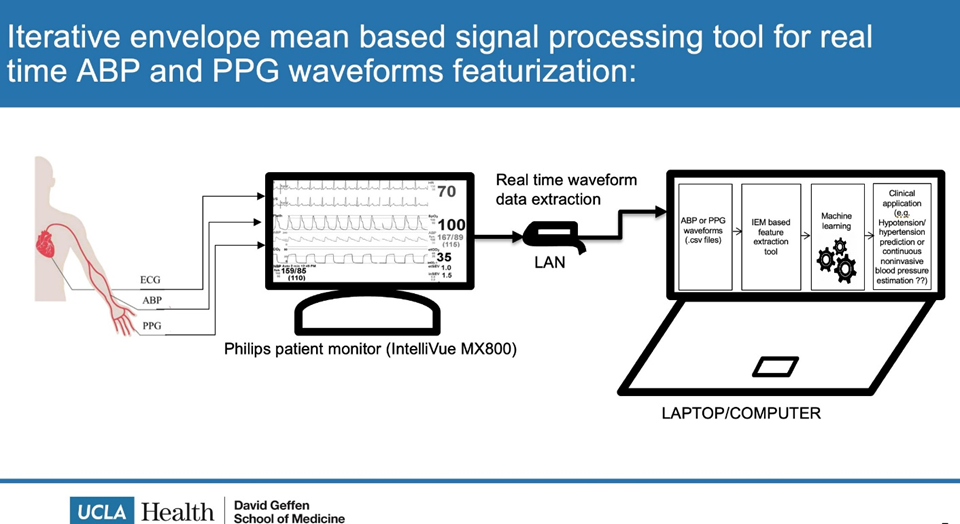Summary:
UCLA Researchers in the Department of Anesthesiology have developed an iterative envelope mean (IEM) method for the detection of specific features in arterial pressure monitoring applications.
Background:
The cardiac cycle consists of the distinct systolic and diastolic phases. The transition from the contracted, systolic phase to the relaxed, diastolic phase is marked by the dicrotic notch. The dicrotic notch is a distinct cardiac feature indicating aortic valve closure and ejection of oxygenated blood to peripheral tissues. Detection of the notch is essential for various clinical and diagnostic purposes including determining cardiac output and facilitating machine learning models for blood pressure estimation and cardiovascular status prediction. Existing technologies for the detection of the dicrotic notch are limited by low and noisy signals. Mathematical models to estimate the dicrotic notch can introduce error, limiting their clinical applicability. There remains an unmet need for a robust and accurate method of detecting specific points in the cardiac cycle, including the dicrotic notch, in the presence of high noise.
Innovation:
Researchers at UCLA's Department of Anesthesiology have developed a method to detect the dicrotic notch using an iterative envelope mean (IEM) method. This technology divides the signal into stationary and non-stationary estimates, effectively reducing noise and demonstrating robustness across various signal-to-noise ratios. This advancement holds promise for enhancing the reliability of cardiovascular diagnostics by enabling clinicians to identify nuanced physiological features such as the dicrotic notch with greater precision, even in waveforms lacking prominent dicrotic notches.
Furthermore, this innovation serves as a signal processing tool, extracting essential features from arterial blood pressure (ABP) and photoplethysmography (PPG) waveforms. It can extract up to 838 features per cardiac cycle, focusing on specific points in the cardiac cycle such as systolic phase onset, systolic phase peak, dicrotic notch, diastolic phase peak, and diastolic phase endpoint. This signal processing tool can be used through a user-friendly interface, allowing clinicians to detect specific events of the cardiac cycle, and facilitating the detection and management of various cardiovascular diseases, including arrhythmia and tachycardia. Integrating this technique into wearable devices offers non-invasive access to valuable insights into patients' cardiac output, heart rate, oxygen saturation, and other crucial vitals, potentially revolutionizing cardiovascular care.

Potential Applications:
- Cardiovascular monitoring
- Cardiovascular estimation
- Emergency medicine
- Telemedicine
- Blood pressure prediction
- Peripheral blood circulation monitoring
- Pulse rate monitoring
- Oxygen saturation monitoring
Advantages:
- Reduced noise
- Improved signal
- Increased accuracy
- Limited mathematical error
Development To Date:
First demonstration of technology is complete as of 7/6/2023.
Reference:
UCLA Case No. 2024-034
Relevant Publications:
Pal, R., Rudas, A., Williams, T. et al. Feature extraction tool using temporal landmarks in arterial blood pressure and photoplethysmography waveforms. npj Cardiovasc Health 2, 57 (2025). https://doi.org/10.1038/s44325-025-00096-0
Ravi Pal, Akos Rudas, Sungsoo Kim, Jeffrey N. Chiang, Anna Barney, Maxime Cannesson, An algorithm to detect dicrotic notch in arterial blood pressure and photoplethysmography waveforms using the iterative envelope mean method, Computer Methods and Programs in Biomedicine, Volume 254, 2024, 108283, ISSN 0169-2607, https://doi.org/10.1016/j.cmpb.2024.108283.
Ravi Pal, Anna Barney, Iterative envelope mean fractal dimension filter for the separation of crackles from normal breath sounds, Biomedical Signal Processing and Control, Volume 66,
2021, 102454, ISSN 1746-8094, https://doi.org/10.1016/j.bspc.2021.102454.
Pal R, Rudas A, Kim S, Chiang JN, Cannesson M. A signal processing tool for extracting features from arterial blood pressure and photoplethysmography waveforms. medRxiv [Preprint]. 2024 Mar 15:2024.03.14.24304307. doi: 10.1101/2024.03.14.24304307. PMID: 38559005; PMCID: PMC10980118.